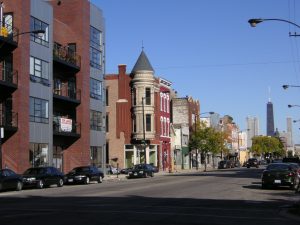44 North America: Urban Geography II – Gentrification

Photo by Eric Allix Rogers on Flickr.
Many urban neighborhoods in the United States began to decline in the 1950s, and many of them have never recovered. But some have. Gentrification is the economic revitalization of a once troubled urban neighborhood. Lower income residents are replaced by higher income residents, and older housing is renovated or replaced. Old industrial landscapes, like warehouses and factories, are renovated as, or replaced by, condos, galleries, clubs, restaurants, theaters, offices, or similar upscale commercial activities.
All major American cities have experienced some gentrification. In Chicago, gentrification has largely been focused on the North Side, although some neighborhoods just south and west of the Loop have gentrified as well. Here is a photo from Chicago Avenue by Eric Allix Rogers.
A major cause of gentrification was simple real estate economics. By the 1980s, real estate in the suburbs had become extremely expensive. At the same time, urban real estate values had collapsed. Magnificent old buildings in the inner city could be purchased for next to nothing. It was only a matter of time before someone rolled the dice and took a chance on redeveloping a decayed inner-city neighborhood. Of course, the city and county governments of these depressed neighborhoods were more than happy to help. Governments gave economic grants and tax incentives to developers willing to revitalize an urban neighborhood. Governments also helped to fund the construction of parks, stadiums, and concert venues to serve as anchors for gentrification.

Other important factors were new environmental laws and the deindustrialization of American cities. Many people fled to the suburbs to avoid the smoke, filth, and crowds of industrial cities. Because of stronger environmental rules, closed factories, and decades of flight to the suburbs, cities had become cleaner and less crowded. They could be a much more pleasant place to live.
Changing cultural conventions in the United States also helped to spur gentrification. One involved sexuality. Prior to the 1960s, it was uncommon for people to be openly gay. In fact, it was illegal. Gay sex was a crime in Illinois until 1962, and remained illegal in many other states for several years after that. Even after legalization, gay Americans continued to face discrimination. Gay bars and clubs were discouraged in the suburbs and in upscale urban neighborhoods, so they often located in economically depressed urban areas. These bars, clubs, and other gay-owned or gay-friendly businesses served as anchors for evolving gay neighborhoods, many of which became some of the first gentrified neighborhoods in their respective cities. New York’s Chelsea, Boston’s South End, Washington’s DuPont Circle, and Chicago’s Boystown are all examples of early gentrification, and all have strong ties to the gay community.
Another important cultural change of the last few decades has been the age at which Americans get married and have children. In the 1950s, most Americans got married shortly after finishing high school or college, and usually had their first child not too long after. The suburbs were, and still are, designed to cater to the needs of the nuclear family – a married couple with children. Compared to cities, the suburbs usually offer larger houses with larger yards. Crime rates are usually lower, and schools are generally better-funded. These are, of course, all things that parents are interested in. So, in the 1950s, middle-class Americans typically finished school, got married, moved to the suburbs, and started a family.
By the 1990s, however, cultural conventions were changing. More people were attending college, and thus getting married later. More women were starting careers, and having children later, or having no children at all. This meant that more people were spending their 20s and early 30s, and perhaps their entire adult life, living outside of a nuclear family. Because of that, the suburbs became less appealing to many people. At the same time, cities were becoming more appealing places to live. Young, college-educated Americans began moving to gentrifying urban neighborhoods.
Perhaps the most important force in gentrification were the DINKs. DINK is an acronym for “Double Income, No Kids,” a term that was popularized in gentrifying neighborhoods in the 1980s. A DINK is someone who lives with his or her boyfriend, girlfriend, or spouse, and does not have children. DINKs are often synonymous with “yuppies” – another 1980s term derived from “young urban professional.” DINKs are young college graduates with white-collar jobs and good incomes.
Because they share the cost of housing, don’t have kids, and make good money, DINKs have loads of disposable income. If you walk through a gentrifying neighborhood and glance in the windows of the trendy restaurants and shops, and wonder who on earth has money to spend on that sort of thing, it’s the DINKs. Not everyone who lives in a gentrifying neighborhood is a DINK, of course, but since the 1980s, gentrifying neighborhoods have evolved around the tastes, and wallets, of DINKs.
Traditionally, DINKs who eventually had kids would move off to the suburbs. That’s changed over the last decade or so. As gentrified neighborhoods have become cleaner and safer, many former DINKs have decided to raise their children there. Oddly, many American parents now have a reverse commute, working in the suburbs, but raising a family in the city, turning the suburban model on its head.
There is no denying the positives of gentrification. It’s great to see historic neighborhoods spring back to life after decades of economic decay. But gentrification has some serious downsides. As soon as a neighborhood begins to gentrify, property taxes and rents spiral upward. Many working-class families who have lived in the same neighborhood for generations suddenly find themselves priced out of it. Neighborhood institutions like churches and ethnic clubs dwindle as their members are forced to move away. Long-standing neighborhood shops, bars, and restaurants close down because rents and property values are too high, or because they don’t cater to the interests of the DINKs. These “mom and pop” shops are soon replaced by national chains. The ethnic and social characteristics that had shaped the neighborhood for generations are lost.
Did You Know?
Cited and additional bibliography:
Rogers, Eric Allix. 2005. Gentrification in Chicago. https://tinyurl.com/gentchicago. Attribution-NonCommercial-NoDerivs 2.0 Generic (CC BY-NC-ND 2.0).


